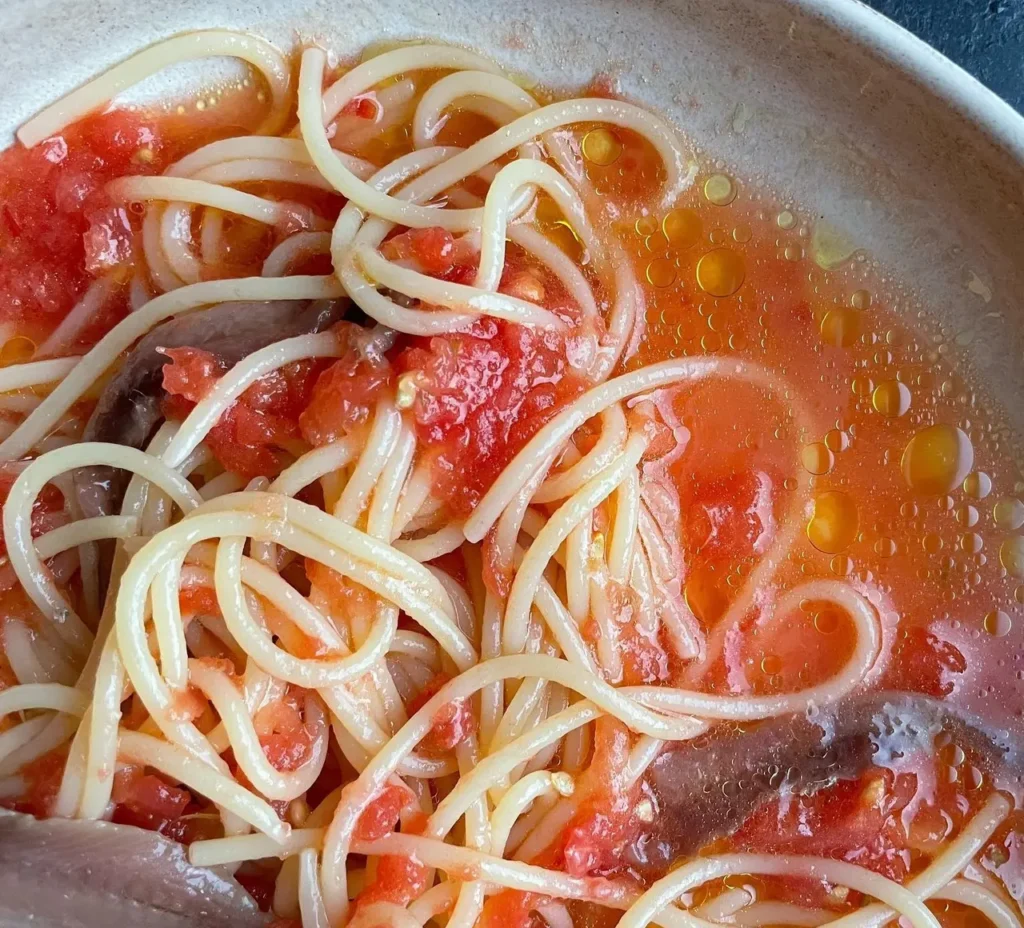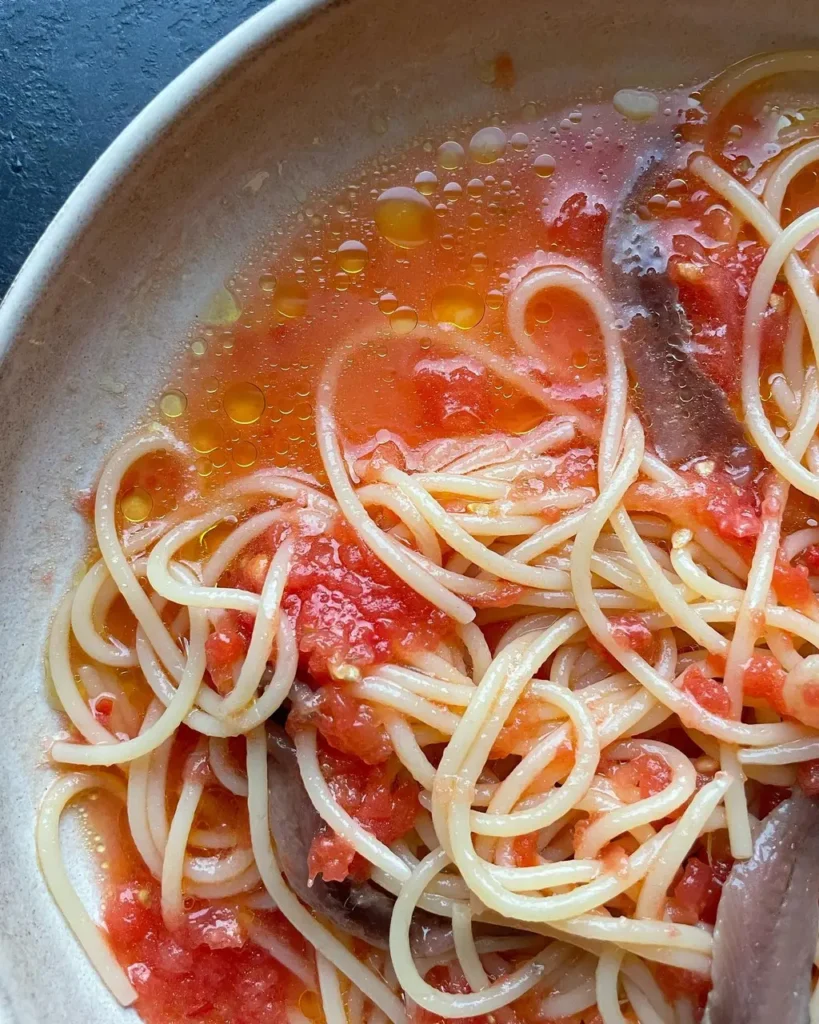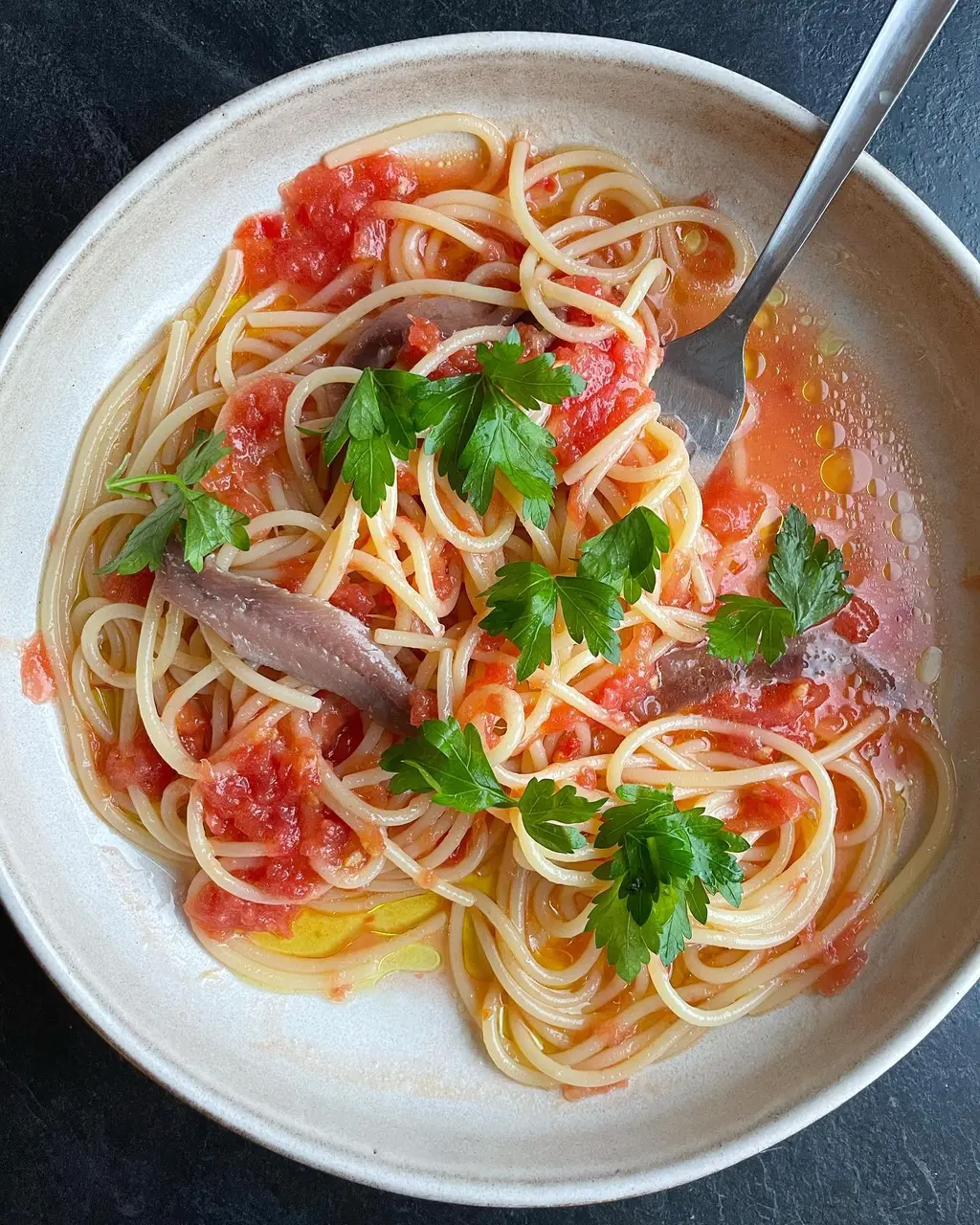Many tomato-based pasta dishes can feel overly heavy or cooked down to the point where the freshness disappears.
This fresh tomato spaghetti with anchovies and parsley keeps everything light, bright, and bursting with real Mediterranean flavor. The grated tomato sauce delivers that just-picked sweetness, the anchovies melt into a savory backbone, and the fresh herbs finish it all off with a burst of color and aroma.
It’s the kind of effortless pasta that feels restaurant-worthy but takes less than 30 minutes to make at home.
The Beauty of Fresh Tomato Sauce
There’s something special about using raw, grated tomatoes instead of canned sauce or slow-cooked passata. When you grate ripe tomatoes, you extract all their juicy flesh and natural sweetness while leaving behind the tough skins.
The result is a silky, rustic sauce that clings beautifully to pasta without feeling heavy.
Unlike simmered sauces that can lose their brightness, this fresh tomato base retains its sunny acidity and garden-fresh flavor. It’s the kind of dish that celebrates simplicity — just a few quality ingredients come together to make something extraordinary.
If you’ve tried miso-glazed eggplant or creamy kale garlic pasta with lemon before, you’ll recognize the same philosophy here: simple techniques, big flavor impact.
Choosing the Right Tomatoes

The key to success in this recipe lies in your tomatoes. You want ones that are ripe, juicy, and deeply flavorful. Look for vine-ripened tomatoes, Roma tomatoes, or even heirloom varieties if they’re in season. They should feel heavy for their size and have a rich aroma at the stem.
Avoid pale or mealy tomatoes — those lack the flavor needed for a raw sauce. If tomatoes are out of season, you can still make this recipe using good-quality cherry tomatoes, which often stay sweet year-round. Simply pulse them in a food processor instead of grating.
Anchovies – The Secret Flavor Powerhouse
Anchovies might sound intimidating, but in this recipe, they’re the magic ingredient. When they hit the warm pasta, they melt into the sauce, creating a deep, savory undertone that makes everything taste more balanced. The result isn’t “fishy” — it’s rich, salty, and umami-packed.
If you’re new to using anchovies, start with a small amount and build from there. They’re one of those ingredients that teach you how a little can go a long way.
For a vegetarian version, you can skip them and replace with a spoon of capers or olive tapenade, which give a similar briny punch.
The Role of Garlic and Olive Oil

Garlic and olive oil are the foundations of Mediterranean cooking, and here they play starring roles.
The garlic is finely grated rather than chopped, which helps it disperse evenly through the tomato sauce. This means every bite has a gentle garlic warmth instead of harsh raw sharpness.
Use high-quality extra virgin olive oil — something fruity and peppery — to enhance the tomato’s sweetness. You’ll need it both in the sauce and drizzled on top before serving. That final drizzle is what ties everything together, giving the pasta a glossy finish and irresistible aroma.
The Perfect Pasta Match
While spaghetti is the traditional choice, this sauce also pairs beautifully with linguine, bucatini, or fettuccine. The key is to use long noodles that allow the light sauce to coat them evenly.
When cooking the pasta, make sure your water is well-salted. It should taste almost like the sea. This step ensures the pasta itself has flavor, which makes a big difference when you toss it with a simple sauce like this one.
Reserve a small cup of pasta water before draining — that starchy liquid is pure gold for emulsifying the sauce later. It helps the tomato mixture cling to every strand of spaghetti without feeling watery.
Bringing It All Together

Once your pasta is cooked and drained, it’s time to assemble. Add it straight into the bowl with your fresh tomato sauce, along with a splash of the reserved pasta water. Toss everything together quickly so the sauce lightly warms and coats the noodles.
You’re not cooking the sauce here — just letting the heat from the pasta take the edge off the garlic and bring all the flavors together. Then, top with your anchovy fillets, freshly chopped parsley, and a drizzle of olive oil.
The whole dish feels alive with texture and contrast — the silky pasta, the juicy tomatoes, the salty anchovies, and the herbal freshness all balance perfectly.
Tips for the Best Fresh Tomato Pasta
To make sure your pasta turns out perfect every time, keep these simple tips in mind:
Use ripe tomatoes only. They’re the heart of the dish. If your tomatoes aren’t flavorful enough, the sauce will taste flat.
Grate carefully. Use the large holes of a box grater and stop before reaching the tomato skin — it adds bitterness.
Don’t over-salt early. Anchovies bring their own saltiness, so taste before seasoning.
Use the pasta water wisely. Add it gradually until the sauce reaches that silky, clingy texture.
Serve immediately. This sauce doesn’t need resting time — it’s meant to be eaten fresh and warm.
If you love quick pasta recipes like this, you’ll also enjoy creamy mushroom tomato ravioli — another 20-minute meal that’s full of rich flavor.
Variations to Try

Once you’ve mastered the basic version, it’s easy to build on this recipe in creative ways.
Add chili flakes for a subtle heat that balances the tomato sweetness.
Toss in olives or capers for a saltier, Mediterranean twist.
Top with breadcrumbs toasted in olive oil and garlic for crunch.
Add grilled shrimp or seared chicken strips for a heartier meal.
Stir in a spoon of ricotta or burrata for creamy contrast.
Each variation keeps the dish light but adds a new layer of personality and texture.
Serving Suggestions
This pasta shines on its own, but pairing it with simple sides elevates it even further. A crisp green salad with lemon dressing or a slice of homemade puffy pita bread complements it beautifully.
If you’re serving this for a dinner party, add a small antipasto platter with marinated vegetables and olives for a true Mediterranean touch.
To keep things balanced, avoid pairing with anything too heavy — the beauty of this dish lies in its freshness.
Storing and Reheating
Because this sauce is uncooked, it’s best enjoyed immediately. However, if you do have leftovers, store them in an airtight container in the fridge for up to 2 days.
When reheating, warm gently in a pan with a splash of water or olive oil. Avoid microwaving directly, as it can dull the flavor and texture.
If possible, refresh with a few halved cherry tomatoes before serving to bring back that juicy brightness.
Common Mistakes to Avoid
It’s such a simple recipe that even small missteps can throw off the balance. Here’s what to watch out for:
Overcooking the pasta. The sauce clings best to al dente noodles, not mushy ones.
Adding sauce too early. Combine just before serving — not while the pasta’s still cooking.
Using old garlic. Fresh garlic adds aroma; stale garlic can overpower with bitterness.
Skipping the olive oil drizzle. That final step enhances both flavor and texture — don’t miss it.
By following these small details, you’ll ensure your pasta tastes like it came straight from a coastal Italian kitchen.
Why This Recipe Works
Every ingredient has a role here. The tomatoes bring natural acidity and sweetness. The anchovies add depth and salt.
Garlic and olive oil weave everything together, while parsley lifts it with a final herbal note. It’s balanced, clean, and full of flavor — the very definition of simple done right.
What’s most appealing is how fast and effortless it feels. There’s no simmering, no complicated steps, just real ingredients working together in harmony. It’s a recipe you’ll reach for again and again, whether it’s a weekday dinner or a quick date-night meal.
Frequently Asked Questions
Can I use canned tomatoes instead of fresh ones?
You can, but it will change the flavor. Fresh tomatoes make the sauce lighter and more vibrant. If using canned, go for high-quality crushed tomatoes and skip the grating step.
Do I have to use anchovies?
They’re optional, but they add beautiful depth. If you prefer to skip them, use a teaspoon of capers or a touch of olive tapenade for similar savory complexity.
What type of pasta works best?
Spaghetti is classic, but linguine or bucatini also work well. Avoid short pasta shapes — they don’t hold the sauce as gracefully.
Can I make the sauce ahead of time?
You can prepare the tomato mixture up to a few hours in advance and keep it chilled. Just bring it to room temperature before tossing with pasta.
Why do you add pasta water?
The starch in the water helps emulsify the sauce, creating that glossy, restaurant-style coating without needing cream or butter.
Is this dish spicy?
Not by default, but adding chili flakes or a drizzle of chili oil gives it a nice kick if you like some heat.
Can I add cheese?
While not traditional, a sprinkle of grated parmesan or pecorino adds richness and balances the acidity of the tomatoes beautifully.
This fresh tomato spaghetti with anchovies and parsley is the kind of meal that reminds you why simple food often tastes best. Every bite bursts with sunshine, freshness, and effortless Mediterranean charm.
Whether you’re cooking for two or treating yourself to a cozy solo dinner, it’s a dish that satisfies without trying too hard — proof that great pasta doesn’t need to be complicated to be unforgettable.

Fresh Tomato Spaghetti with Anchovies and Parsley
Ingredients
Method
- Cook the pasta in a large pot of salted boiling water according to package instructions until al dente.
- Reserve a small cup of pasta water before draining.
- Grate the halved tomatoes using the large holes of a box grater and discard the skins.
- In a bowl, combine the grated tomatoes, grated garlic, olive oil, and salt to taste.
- Run the cooked pasta under cold water briefly to stop cooking.
- Toss the pasta with the fresh tomato sauce, adding a splash of reserved pasta water to coat evenly.
- Top with anchovy fillets, chopped parsley, and a drizzle of olive oil before serving.
Notes
- Use ripe, heavy tomatoes for the freshest flavor.
- Anchovies can be omitted or replaced with capers for a vegetarian alternative.
- Serve immediately for the best taste and texture.


Leave a Reply